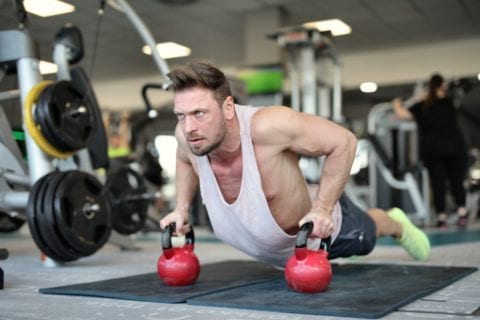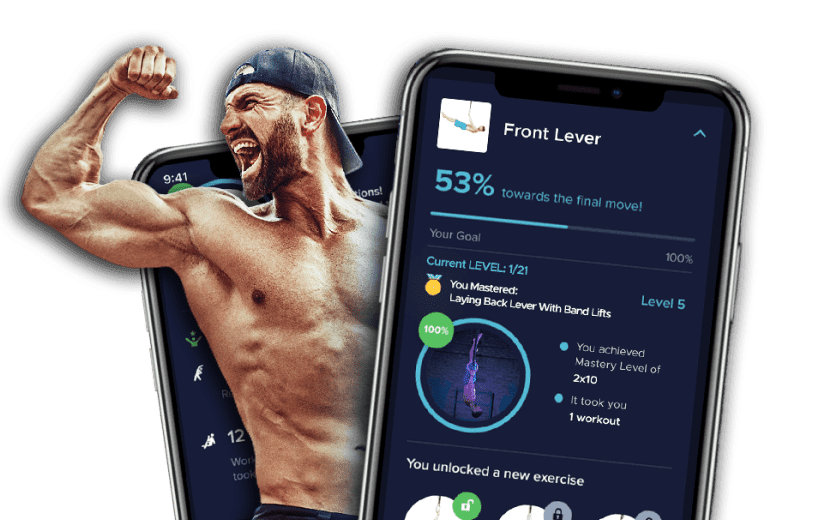Join the tribe of Movement & Calisthenics Athletes – people just like you that are working with their own body weight to get strength, lose fat, build muscle, recover from injuries, and live their best lives!
One thing that always amazed me about calisthenics and bodyweight training is how both naturally normalize and regulate your body fat levels.
Again and again and again I have seen guys and girls who take up bodyweight training naturally drop flab, just as a side effect of their fitness.
How is it possible?🤔
🔎 Why is calisthenics so effective for fat loss?
But first, let’s check the difference between fat loss and weight loss.
Weight loss is the reduction of total body mass. This means including fat and lean muscles.
Fat loss is the reduction of body fat. This is what we’re aiming for since we want to retain or improve our lean muscles so we can get stronger as we lose fat.
So we encourage you to later read our article on how to build muscle and lose fat at the same time.
Now that’s resolved, let’s talk about the 4 reasons why calisthenics is so effective for fat loss.
- Body’s adaptation to bodyweight training
- Compound exercises
- Mixture of resistance and cardio
- Progressive nature
1. Body’s adaptation to bodyweight training 💪
Body fat and Calisthenics are natural enemies. If your goal lifting is to bent-over row 400 lbs., you could overeat as much as you like and probably still meet your weight despite carrying around a massive gut.
But you couldn’t set a goal of doing one-arm pull-ups without watching your bodyweight. When you bulk up from Calisthenics and Bodyweight training it’ll be because you NEED that muscle. You’ll NEVER gain unneeded fat while training because your body recognizes that slows down your bodyweight aspirations.
The power of your subconscious mind 👈
The goal of calisthenics is to master lifting one’s own body. The fatter you are, the more difficult this becomes. Once you begin training regularly in calisthenics, the subconscious mind makes the connection between a leaner body weight and easier training, and regulates the appetite and eating habits automatically.
How is it possible? It’s actually very simple. Imagine you are doing a handstand pushup. You are training your body telling it that this is what it needs to handle, handle the weight drops to the appropriate level. And as you are training all the muscles it builds an incredible natural physique.
2. Compound exercises 🤸♀️
The actual key to losing fat is done in the kitchen but doing calisthenics helps your life a lot easier.
In order to lose fat, you need to make sure that the calories you intake are LESS than the calories your body consumes.
That’s where calisthenics comes into play.
Majority of calisthenics exercises consist of compound, multi-jointed exercises. This simply means that multiple joints and muscle groups are targeted when performing the exercises. No isolation of joints or muscle groups.
How does this help you?
Compound exercises are much more demanding which stimulates more muscle growth and burns more calories.
As supported by a recent research done in 2017, resistance training with compound exercises promotes better strength, muscular gains and fat loss compared to single-joint (isolation) exercises.
Just think of it. Compound exercises, such as pull-ups, push-ups, require you more effort to execute the exercise compared to a bicep curl or tricep extension.
This higher demand pushes your body to burn more calories, use more energy to be able to complete the exercise.
3. Mixture of Resistance and Cardio 👊💪
Calisthenics has tons of exercises that focus on mobility, flexibility, strength, muscle, skill and even cardiovascular endurance.
With that in mind, you can train with calisthenics as resistance training and cardio. Why? Because choosing to train both helps cut fat while maintaining your lean muscles.
Although it is found in a scientific study that aerobic exercise (cardio) is faster for shedding fat, it also makes you lose your lean muscles.
Faster fat loss? Tempting, isn’t it?
But you don’t want to have less fat on your legs but you’ll also have weaker knees in the process. It kinda defeats the purpose of training for health since you’ll be leaving out an important aspect of health.
When training with calisthenics, you don’t have to worry about what type of aerobic exercise you have to do since calisthenics can be exactly the aerobic/cardiovascular condition for you.
4. Progressive 🤛
Common notion of people new to calisthenics is that there are only 4 exercises important: push-ups, pull-ups, dips and squats. Then there’s also the case that calisthenics is either just too easy or too difficult.
That’s not the case.
Aside from the 4 mentioned exercises (which are very crucial i must say), there are tons of exercises and other variations of the 4 to provide the necessary stimulation for any skill level.
That’s right, ANY SKILL LEVEL.
Calisthenics is progressive and plays with physics and levers in order to increase intensity. The progressive nature provides enough challenge to any level so you can burn your calories and build muscle: ultimately leading to fat loss.
Drop the flab and build natural physique of a gymnast👊
If you are a few pounds off you still will need a clean diet regime. But bodyweight training will naturally shed you and give you the best possible, natural results. I know this is true-I’ve seen it myself on many occasions. Guys who take up bodyweight training naturally drop flab and eventually have 6 pack abs.
☝️Try it for yourself and see.
2 Rules of shredding fat with just bodyweight training 💪💪💪
The bodyweight training will regulate your body fat naturally, but you still need to put the work in.
Just to make it clear, what you really want is to shred fat and build muscles at the same time.
In terms of shredding fat with calisthenics, there are 2 rules to follow:
- 👌 Eat Clean
Diet is 80% of your success. Keep it simple and just follow the rules of Lean Mean Calisthenics Diet.
Whatever exercise approach you choose, if you don’t follow a good proper diet, all of your efforts will be worthless.
As the saying goes, “abs are made in the kitchen.”
We kid you not with this old adage. Caloric deficit (less calories than calories consumed) is the only way for you to lose fat.

- 👊 Train with RIGHT intensity
Training with an unstructured program or a program not appropriate for your level will only do harm than good.
Doing unstructured training is too random. It’s like walking in a maze trying to reach your goal. You’re not sure if you’re going to lose weight or not.
Too easy then the workout can still help in losing fat but will not maximize the calories you could have burned. Leading to no progress or very little progress. Leaving you unmotivated and ultimately, quitting your fitness journey.
Too difficult then it can still burn calories but you’ll overtrain and your body wouldn’t be able to recover properly. This could possibly lead to injuries, aches and pains and of course, demotivation (AKA quitting).
The best way to train for fat loss is to find the difficult just enough for you.
That’s when programs like from The Movement Athlete come into play.
Providing you an adaptive program that is tailored specifically for your goals, skill level and lifestyle.

Ready to lose fat and build muscles naturally?
I know that losing fat and building muscles is what many of you aspire for. I also know it can get very confusing.
Not to worry!
The Movement Athlete Academy is here to guide you on your journey.

Reference:
Paoli, A., Gentil, P., Moro, T., Marcolin, G., & Bianco, A. (2017). Resistance Training with Single vs. Multi-joint Exercises at Equal Total Load Volume: Effects on Body Composition, Cardiorespiratory Fitness, and Muscle Strength. Frontiers in physiology, 8, 1105. https://doi.org/10.3389/fphys.2017.01105
Willis, L. H., Slentz, C. A., Bateman, L. A., Shields, A. T., Piner, L. W., Bales, C. W., Houmard, J. A., & Kraus, W. E. (2012). Effects of aerobic and/or resistance training on body mass and fat mass in overweight or obese adults. Journal of applied physiology (Bethesda, Md. : 1985), 113(12), 1831–1837. https://doi.org/10.1152/japplphysiol.01370.2011

UNSURE HOW TO GET STARTED
Get a FREE personalized plan here
(No strings attached)